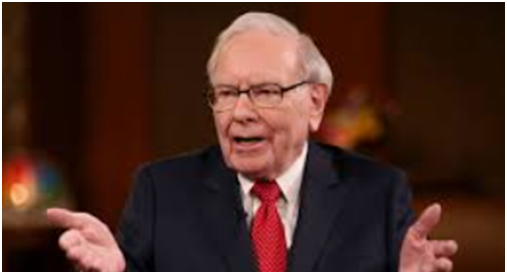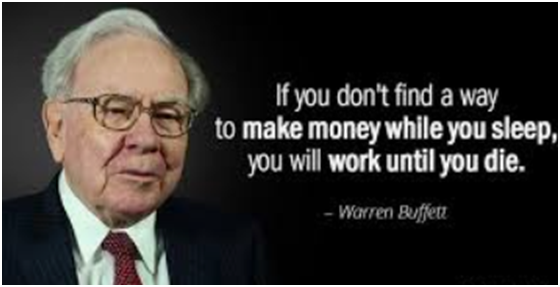Here's What Warren Buffett is Doing as the US Stock Market Plunges
Buffett's actions may seem counter-intuitive to new investors: More experienced investors get it.
Hey, it’s George. Thanks for reading today. Retirement: One Dividend at a Time is a reader-supported publication. Our goal is to bring you fact-filled, useful analysis that helps you reach your retirement goals with a growing stream of passive dividend income. We don’t have corporate backers, and would be so grateful if you took a moment to follow me and subscribe for free emails. This will get you an immediate notification whenever I publish new articles.
I invite you to subscribe also to my growing and more substantive Substack newsletter, here.
Warren Buffett’s gone through multiple stock market crashes and corrections. I have, too, though not quite as many as Buffett. After all, he’s some 20 years my senior. Today's volatile market has new investors sitting on the edge of their seats biting their nails and panicking as major indexes decline 10% or more, clearly fitting the definition of a correction.
His advice for navigating volatile markets has experienced investors, though, chomping at the bit, ready to pounce on bargains brought about by the meltdown, not to mention the accidentally high dividend yields that come with bargain basement stock prices. In this regard, Buffett famously said, “If you don’t find a way to make money while you sleep, you will work until you die.”
When investing, it's wise to remember your capital is always at risk. The value of your investments can go down as well as up and you may get back less than you put in.
Having kicked off his investment journey at the age of 11, the same tender age as me, Warren Buffett’s no stranger to stock market volatility. But for newer investors, the last few weeks have been particularly unpleasant, especially for those allocating capital in the U.S markets.
And what has Buffett been doing with his Berkshire Hathaway (Brk-B) portfolio? Well, naturally, he’s been selling off huge chunks of his portfolio, some $330 billion, since last year, building up his cash pile, tailored for moments just like this. He has recently decried the administration’s tariff policy, loudly voicing his concern that imposing tariffs constitutes “waging a trade war”, plain and simple, and not good for the economy, no less the stock market. The Smoot Hawley tariffs of the 1930’s didn’t work out so well either. History shows it lead to a 90% decrease in stock prices. Ugh!
The US offers a lot of exciting growth opportunities for international investors, especially within the technology sector. However, compared to European shares, US stocks can be significantly more volatile. That’s been made perfectly apparent, with some of the most popular stocks to own, like Tesla, Nvidia, and Alphabet, falling by double digits lately. Tesla has given up almost 50% of its market capitalization. Elon Musk can't be too happy seeing his personal wealth from Tesla decking by $200 billion in a matter of months. However, if he's confident in his auto manufacturing firm, perhaps he's now taking Buffett's advise and buying more shares at half price.
As unpleasant as it can be to watch a growth portfolio suffer, volatility creates interesting opportunities for prudent individuals with an appetite for risk.
Billionaire Buffett is certainly part of this group with a habit of going on a shopping spree whenever everyone else starts panic selling. He has told BKH investors at annual company meetings on several occasions, he likes to be fearful when other investors are greedy. Conversely, he likes to be greedy when other investors are fearful, like now.
Given his impressive performance track record, heeding Buffett's advice could be a critical first step to profiting from the recent chaos. So what does the ‘Oracle of Omaha’ advise investors to do in situations like today?
“If a business does well, the stock eventually follows”
-Warren Buffett
In the short term, a stock price is driven by the mood and momentum of investors. However, in the long run, the value is derived from the value of the underlying business. That’s why Buffett is always exclusively focused on the performance of companies rather than that of stocks.
For newer investors, that’s easier said than done. After all, suffering a double-digit decline is hardly fun. And buying more shares when prices are in free-fall can sound idiotic.
Yet this is precisely how Buffett has achieved market-beating returns over the last 60 years. And it’s the same tactic I deployed back in 2020. Covid-19 led to a general shutdown of most of the economy in March of that year, and the S&P 500 index saw a rapid decline of over 30% of its market capitalization wiped out. I did the same in the financial crisis of 2008-2009 when stocks fell 57%. Talk about bargain basement shopping!
Many of the companies in our RODAT Portfolio ( Retirement: One Dividend at a Time) undoubtedly encountered some headwinds from fears of how the Covid economic shutdown would impact stocks.
However, as the headwinds from the Covid Pandemic turned into tailwinds, the portfolio's long-term strategy remained unscathed, with the underlying businesses continuing to chug along nicely despite what the crashing share prices suggested. And, for the most part, dividends continued to be paid and raised by the companies that found their footing and opportunity in such a debacle.
As such, I started snapping up more shares in June 2020 and our subscribers have been subsequently rewarded with impressive double- and even triple-digit returns since. Not to mention accidentally high dividend yields of 10% or higher, from stocks that historically paid dividend yields around 5% or lower.
“Where Does the Risk Come From? Not Knowing What You’re Doing”
-Buffett Wisdom
Blindly buying more shares in portfolio positions with falling stock prices isn’t a winning strategy. It’s essential to discover what’s driving the valuation in the wrong direction. Is it just short-term investor pessimism and panic? Or is there a fundamental problem with the business that’s recently come to light?
If it’s the latter, then selling, even at a loss, might be far less risky than holding on or buying more. Even Buffett’s learned this lesson the hard way with a company called Dexter Shoes. A failure of competitive analysis resulted in a $433m investment eventually tumbling to zero.
Your Takeaway
Stock prices always reflect two opposite sides of the spectrum; investor enthusiasm and momentum can drive prices skyward. If company performance reflects this enthusiasm, momentum can continue driving prices higher.
However, if a negative catalyst hits the tape and the company has no clear path back to profitability, momentum can cascade, driving the stock's price lower and lower.
In other words, by staying informed about what could go wrong as well as what could go right, investors can avoid costly mistakes as well as make brilliant moves on their journey to building wealth.
Retirement: One Dividend at a Time is a reader-supported publication. To receive new posts and support my work, consider becoming a free or paid subscriber.
Subscribers to the Retirement: One Dividend At A Time investment newsletter who mirror the RODAT Portfolio have annual income in excess of $132,000.00 from dividends alone.
I don’t have investors or work for a large corporation. My work is fueled by people like you. If you enjoyed this article, would you consider supporting me?
Other articles with over 80,000 views each that readers found worthwhile reading:
Turn $20,000 in Savings into $1000 a Month in Passive Income
It’s easier than you might think to generate $1,000 a month from just $20,000.medium.com
Eroxon Beats Viagra Hands Down
Beating off and intimate sex has just gotten way easier and faster.medium.com
Stocks Threatened with Administration’s Demolition
A demolition derby may be approaching; sell, sell, sell!medium.com
Get Rich as Your Portfolio Collapses
Losing money is the quickest way to earn riches.medium.com
Best,
George Schneider, M.A.
Founder and publisher
Retirement: One Dividend At A Time
Disclaimer: This article is intended to provide information to interested parties. As I have no knowledge of individual investor circumstances, goals, and/or portfolio concentration or diversification, readers are expected to complete their own due diligence before purchasing any stocks mentioned or recommended.
Disclosure: I am long all RODAT Portfolio names. The Portfolio continues to build dividend income with reliable, dependable equities which have long histories of increasing the dividend.
Copyright ©2025, George Schneider










